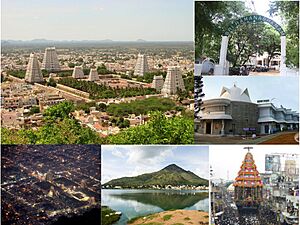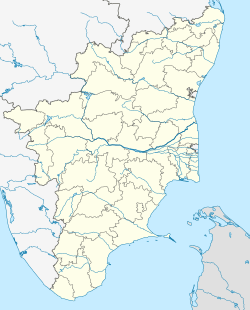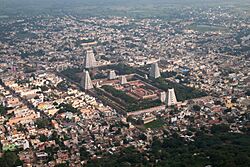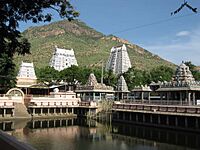Tiruvannamalai facts for kids
Quick facts for kids
Tiruvannamalai
Tiruvarunai
|
|
|---|---|

Clockwise from top left: view of Tiruvannamalai with Annamalaiyar Temple towers in the centre and hills in the background, Sri Ramana Ashram entrance, Yogi Ramsuratkumar Ashram, Great Chariot, view of Annamalai Hill from outskirts, Tiruvannamalai at night.
|
|
| Country | |
| State | Tamil Nadu |
| District | Tiruvannamalai |
| Taluk | Tiruvannamalai |
| Region | Vellore |
| Government | |
| • Type | Mayor–council |
| • Body | Tiruvannamalai Municipal corporation |
| Area | |
| • City | 13.64 km2 (5.27 sq mi) |
| Elevation | 171 m (561 ft) |
| Population
(2011)
|
|
| • City | 145,278 |
| • Rank | 22nd (in Tamilnadu) |
| • Metro | 398,100 |
| Languages | |
| • Official | Tamil |
| Time zone | UTC+5:30 (IST) |
| PIN |
606 601 to 606 611
|
| Telephone code | 91-4175 |
| Vehicle registration | TN 25 |
| Member of Legislative assembly | E. V. Velu (DMK) Tiruvannamalai Assembly constituency K. Pitchandi (DMK) Kilpennathur Assembly constituency (partly) |
Tiruvannamalai is a lively city in the Indian state of Tamil Nadu. It's a very important place for culture and spirituality. The city is famous for its ancient Annamalaiyar temple and the sacred Annamalai hill. Many people visit Tiruvannamalai for its special festivals like Karthigai Deepam and the Girivalam walk around the hill.
Tiruvannamalai is also a busy center for business. It has many shops, resorts, and fun activities. The city is home to industries like SIDCO and spinning mills. It also has good schools and colleges. The city is managed by the Tiruvannamalai City Municipal Corporation. It has good roads and railway lines that connect it to big cities like Chennai (about 150 km away) and Bengaluru (about 145 km away). There are even plans for a new airport in the future!
Contents
- What's in a Name? Legends of Tiruvannamalai
- A Look Back: History of Tiruvannamalai
- Exploring Tiruvannamalai's Geography
- People and Population: Demographics of Tiruvannamalai
- How Tiruvannamalai Earns Its Living: Economy
- Culture and Traditions in Tiruvannamalai
- Getting Around: Transport in Tiruvannamalai
- Learning and Living: Education and Services
- Villages
- See also
What's in a Name? Legends of Tiruvannamalai
Tiruvannamalai has a special meaning in its name, connected to ancient stories. These stories explain why the city and its famous hill are so important.
The Story of Light and Darkness
In Hindu beliefs, there's a story about Parvati, who is the wife of Shiva. One day, while playing in a garden on Mount Kailash, Parvati playfully covered Shiva's eyes. Even though it was just a moment for the gods, the whole universe lost its light for many years. The Earth became very dark.
To bring back the light, Parvati and other followers of Shiva prayed very hard. Shiva then appeared as a giant column of fire on top of the Annamalai hills. This brought light back to the world. After this, Shiva joined with Parvati to become Ardhanarishvara, a form that is half-female and half-male. The Annamalai hill, which is also called the red mountain, is seen as a holy symbol of Shiva himself. It's like a lingam, which is a special representation of Shiva.
The Challenge of the Flame
Another story tells of a time when the gods Vishnu and Brahma argued about who was more powerful. To settle this, Shiva appeared as a huge flame. He challenged them to find where the flame began and where it ended.
Brahma turned into a swan and flew high into the sky to find the top of the flame. Vishnu became a boar named Varaha and dug deep into the earth to find its base. This scene is often shown in temples and is called lingothbava. Neither Brahma nor Vishnu could find the end or beginning of the flame. Vishnu admitted he couldn't do it. But Brahma lied and said he had found the top. Because Brahma lied, Shiva decided that Brahma would not have temples built for him on Earth.
In the Tamil language, Arunam means red or fire, and Asalam means hill. Since Shiva appeared as fire here, the name Arunachalam became linked to the Annamalai hill and the city. The name Annamalai was first mentioned in a very old Tamil religious book called Tevaram in the seventh century.
A Look Back: History of Tiruvannamalai
The history of Tiruvannamalai is closely tied to its famous Annamalaiyar Temple. Records show that the city's history goes back to the ninth century.
Early Rulers and Temple Growth
Before the ninth century, Pallava kings, whose capital was Kanchipuram, ruled this area. In the seventh century, famous saints called Nayanars wrote poems about the Annamalaiyar temple. These poems are found in a work called Tevaram.
The Chola Kings ruled Tiruvannamalai for over 400 years, from 850 to 1280. They were big supporters of the temple. Inscriptions from their time show that they gave many gifts to the temple, like land, animals, and oil. These gifts often celebrated their victories.
The Vijayanagara Empire's Influence
Later, the Hoysala kings made Tiruvannamalai their capital in 1328. This happened after their kingdom in Karnataka was taken over by the Delhi Sultanate. They fought against other rulers until 1346.
The Vijayanagara Empire also had a strong connection to Tiruvannamalai. Many inscriptions from this empire show that their rulers gave gifts to the temple. These inscriptions were mostly in Tamil, but some were in Kannada and Sanskrit. Tiruvannamalai was an important place during this time. It connected holy pilgrimage sites and military routes. The city grew around the temple, much like other cities ruled by the Nayak kings, such as Madurai.
Changes in Control: 18th and 19th Centuries
In the 18th century, Tiruvannamalai was ruled by the Nawab of the Carnatic. But as the Mughal empire weakened, the city faced a lot of changes and confusion after 1753. Different rulers, both Hindu and Muslim, took control of the temple.
European powers also became involved. The French took over the city in 1757, and then the British gained control in 1760. In 1790, Tippu Sultan captured Tiruvannamalai. Finally, in the early 1800s, the city came under British rule.
Exploring Tiruvannamalai's Geography
Tiruvannamalai is located about 196 kilometers (122 miles) from Chennai, the state capital. It's also about 210 kilometers (130 miles) from Bangalore. The famous Annamalai hill is about 813 meters (2,669 feet) tall.
The city is mostly flat, gently sloping from west to east. The temperature in Tiruvannamalai can get quite hot, reaching up to 40°C (104°F). The coolest months are December and January, with temperatures around 20°C (68°F).
Tiruvannamalai doesn't get a lot of rain, with an average of 815 mm (32 inches) each year. Most of the rain falls during the northeast monsoon, which happens in October, November, and December. The city covers an area of about 16.3 square kilometers (6.3 square miles).
| Climate data for Tiruvannamalai (2002–2021) | |||||||||||||
|---|---|---|---|---|---|---|---|---|---|---|---|---|---|
| Month | Jan | Feb | Mar | Apr | May | Jun | Jul | Aug | Sep | Oct | Nov | Dec | Year |
| Record high °C (°F) | 35.3 (95.5) |
39.8 (103.6) |
42.8 (109.0) |
44.4 (111.9) |
45.0 (113.0) |
44.3 (111.7) |
40.9 (105.6) |
39.4 (102.9) |
39.6 (103.3) |
39.2 (102.6) |
35.8 (96.4) |
35.0 (95.0) |
45.0 (113.0) |
| Mean daily maximum °C (°F) | 29.2 (84.6) |
32.0 (89.6) |
35.0 (95.0) |
37.1 (98.8) |
38.5 (101.3) |
36.3 (97.3) |
34.6 (94.3) |
34.0 (93.2) |
34.0 (93.2) |
33.0 (91.4) |
29.5 (85.1) |
28.3 (82.9) |
33.5 (92.2) |
| Mean daily minimum °C (°F) | 18.2 (64.8) |
19.2 (66.6) |
21.3 (70.3) |
24.8 (76.6) |
26.3 (79.3) |
26.0 (78.8) |
25.1 (77.2) |
24.6 (76.3) |
24.1 (75.4) |
22.9 (73.2) |
20.8 (69.4) |
19.2 (66.6) |
22.7 (72.9) |
| Record low °C (°F) | 10.2 (50.4) |
12.0 (53.6) |
12.1 (53.8) |
13.8 (56.8) |
18.1 (64.6) |
19.6 (67.3) |
18.8 (65.8) |
18.7 (65.7) |
18.7 (65.7) |
15.6 (60.1) |
12.1 (53.8) |
9.3 (48.7) |
9.3 (48.7) |
| Average precipitation mm (inches) | 9.0 (0.35) |
7.1 (0.28) |
5.9 (0.23) |
21.8 (0.86) |
83.9 (3.30) |
71.0 (2.80) |
117.0 (4.61) |
200.9 (7.91) |
200.6 (7.90) |
250.9 (9.88) |
400.2 (15.76) |
150.6 (5.93) |
1,800.9 (70.90) |
| Average precipitation days | 0.8 | 0.5 | 0.4 | 1.3 | 4.7 | 5.3 | 6.6 | 7.8 | 7.6 | 9.4 | 7.7 | 3.9 | 56 |
| Source: India Meteorological Department, | |||||||||||||
People and Population: Demographics of Tiruvannamalai
| Religious census | ||||
|---|---|---|---|---|
| Religion | Percent(%) | |||
| Hindu | 82.57% | |||
| Muslim | 14.07% | |||
| Christian | 2.79% | |||
| Jain | 0.4% | |||
| Sikh | 0.01% | |||
| Buddhist | 0.01% | |||
| Other | 0.13% | |||
| No religion | 0.01% | |||
| Historical population | ||
|---|---|---|
| Year | Pop. | ±% |
| 1951 | 35,912 | — |
| 1961 | 46,441 | +29.3% |
| 1981 | 89,462 | +92.6% |
| 1991 | 109,196 | +22.1% |
| 2001 | 130,350 | +19.4% |
| 2011 | 145,278 | +11.5% |
Sources:
|
||
In 2011, Tiruvannamalai had a population of 145,278 people. There were slightly more females than males, with 1,006 females for every 1,000 males. About 15,524 children were under the age of six.
Most people in Tiruvannamalai can read and write. The average literacy rate was 78.38%. Tamil is the official language spoken here.
When it comes to religion, most people in Tiruvannamalai are Hindus (82.57%). There are also many Muslims (14.07%) and Christians (2.79%). Smaller numbers of Jains, Sikhs, and Buddhists also live in the city.
The city's population grew a lot between 1971 and 1981. After that, the growth slowed down a bit. This was because more industries started to develop outside the main city area.
How Tiruvannamalai Earns Its Living: Economy
Tiruvannamalai is known as a temple city and a major place for religious trips in Tamil Nadu. This means that many people visit, which helps the city's economy.
Key Industries and Services
The city serves as a market and service center for the surrounding areas. Since it's the main office for the Tiruvannamalai district, many jobs are in the service sector. Trading, commerce, and other services are the biggest parts of the city's economy.
In 1991, most people (70.73%) worked in the service sector. Fewer people worked in farming (7.93%) or manufacturing (21.34%). As the city has grown, more people have moved into service jobs. There isn't much farming happening right inside the city.
The manufacturing sector includes oil mills, rice mills, and other food-related businesses. These have stayed pretty steady over the years. The service sector, which includes trade, transport, and communication, has grown a lot. This is because more and more tourists come to visit the city. The popular Girivalam walk around the hill also creates many small businesses around the city.
Banking and Financial Services
Tiruvannamalai has many banks, both national and private. These include big names like State Bank of India, ICICI Bank, and HDFC Bank. All these banks have automated teller machines (ATMs) located throughout the city, making it easy for people to access their money. There are also smaller finance banks available.
Culture and Traditions in Tiruvannamalai
The Annamalaiyar Temple is the most famous building in Tiruvannamalai. It's a huge temple complex, covering about 10 hectares (25 acres), making it one of the largest in India. The temple has four tall entrance towers called gopurams. The tallest one is on the eastern side, with 11 stories and a height of 66 meters (217 feet). This makes it one of the tallest temple towers in India.
Inside the temple, there are many smaller shrines. The most important ones are for Annamalaiyar and Unnamulai Amman. The temple also has many halls, including a famous thousand-pillared hall built during the Vijayanagar period.
The Annamalaiyar temple is one of the Pancha Bhoota Stalas. These are five special Shiva temples, each representing a natural element like land, water, air, sky, or fire. In the Annamalaiyar temple, Shiva is believed to have appeared as a huge column of fire. The temple is also linked to the Manipooraga chakra, which is a concept in human anatomy. The temple is mentioned in old Tamil religious texts, showing its long history and importance.
Festivals and Pilgrimages
The most important festival at the Annamalaiyar temple is the Karthikai Deepam. It's celebrated in the Tamil month of Karthikai, usually between November and December. The festival ends with a huge lamp being lit on top of the Annamalai hills. This lamp uses three tons of ghee (clarified butter)! During this time, the temple deity is carried around the mountain. This festival has been celebrated since the Chola period (850–1280).
Every full moon, thousands of pilgrims walk barefoot around the Annamalai hill. This walk is about 14 kilometers (8.7 miles) long and is called Girivalam. People believe that this walk helps remove sins and fulfill wishes. Along the way, there are many small shrines, meditation halls, and springs where people make offerings.
Other Interesting Places to Visit
- Tirumalai is an ancient Jain temple complex just outside Tiruvannamalai. It has three Jain caves, four Jain temples, and a 16-foot (4.9-meter) tall sculpture of Neminatha from the 12th century. This is the tallest Jain image in Tamil Nadu.
- The Ramana Ashram and the ashram of Yogi Ramsuratkumar are also popular places to visit near the Annamalai hill.
- The Sathanur Dam is about 20 kilometers (12 miles) southwest of the city. It's a great spot for a picnic. This large dam is 44.81 meters (147 feet) high and can hold a lot of water. There's also a beautiful park next to the dam.
- The Ulagalantha Perumal Temple in Tirukoilur and Thiruvarangam are important Vishnu temples near Tiruvannamalai.
Getting Around: Transport in Tiruvannamalai
Tiruvannamalai is well-connected by roads and railways. Two national highways, NH 77 and NH 38, pass through the city. The city also has eight main roads that connect it to other towns.
Bus Services
The TNSTC operates city bus services within Tiruvannamalai and to nearby areas. There are also private mini-bus services for local travel. The main bus stand is in the center of the town.
You can find regular inter-city bus services from Tiruvannamalai to many other towns and cities. The TNSTC offers daily services to places like Chennai, Bengaluru, Villupuram, and Puducherry. You can also book tickets at a computerised reservation center in the bus stand.
Train Services
The Tiruvannamalai railway station is on the railway line from Katpadi to Villupuram. It's part of the Tiruchchirapalli division of the Southern Railway.
There are trains like the Rameshwaram-Tirupati express that connect Tiruvannamalai to cities like Madurai and Tirupati. Passenger trains also run between Katpadi and Villupuram.
Air Travel
The closest airport to Tiruvannamalai is the Chennai Airport. It is about 172 kilometers (107 miles) away from the city.
Learning and Living: Education and Services
Tiruvannamalai has many schools and colleges for students. There are 45 elementary schools, 12 high schools, and 28 higher secondary schools. For higher education, the city has seven arts and science colleges, six engineering colleges, one law college, and two medical colleges.
Utility Services
- Electricity: The Tamil Nadu Electricity Board (TNEB) manages and distributes electricity in Tiruvannamalai.
- Water Supply: The city gets its water from the Thenpennai river and Samuthiram. In 2000–2001, about 12.5 million liters of water were supplied daily to homes.
- Waste Management: Around 52 metric tonnes of solid waste are collected every day. The city has an underground drainage system for wastewater, which was fully completed in 2013–2014.
- Healthcare: Tiruvannamalai has several hospitals and health centers. These include three government hospitals, two municipal maternity hospitals, and many private clinics.
- Street Lighting: The city has over 13,570 street lamps to keep the streets lit at night.
- Markets: There are seven markets in Tiruvannamalai, including flower and vegetable markets. These markets serve the needs of both the city and nearby rural areas.
Villages
- Ariyathur
- Kilnathur
- Mel-chengam
- Saron, Thiruvannamalai
- Thenmathur
See also
 In Spanish: Tiruvannamalai para niños
In Spanish: Tiruvannamalai para niños







